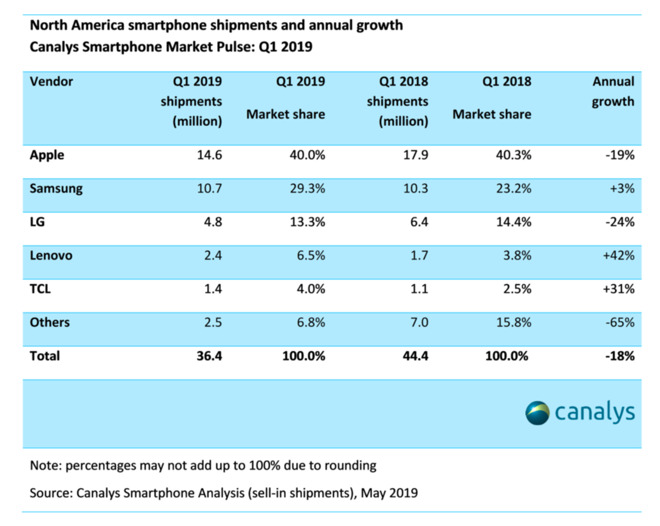Apple shipped 4.5M iPhone XRs in North America last quarter, estimates say
The iPhone XR was easily the most popular smartphone in North America during the March quarter, with shipments of about 4.5 million, according to Canalys research estimates.

If accurate, the figure gives the XR a 13 percent marketshare versus all other smartphones. The next-best results came for Samsung's Galaxy S10+ and S10e, which each reached 2 million units, or 6 percent.
Overall Apple reportedly shipped 14.6 million iPhones, down 19 percent year-over-year but still enough to take a 40 percent of the market. Samsung's marketshare rose from 23 to 29 percent, which Canalys credits to an early launch for the S10 line and attractive features, such as a triple-lens rear camera and a "hole-punch" edge-to-edge display, interrupted only by the front-facing camera.
"Samsung also benefited from carrier promotions in Q1, which used the Galaxy S10e as an incentive," wrote analyst Vincent Thielke.
Apple relied on trade-in promotions, as well as retail and carrier discounts on older hardware. There was allegedly a "disconnect between channel orders and consumer demand," but with an "uptick" in XR shipments in March.
The company's main obstacle moving into 2020 is that recent iPhones are "just not different enough," Thielke argued. "For its performance to improve in 2020, Apple will need to emphasize radical new features that are most likely to impress consumers."
The North American smartphone market as a whole dropped 18 percent to 36.4 million units, the lowest amount in five years. Canalys blamed this on "lackluster peformance by Apple," and the relative absence of ZTE, which was blocked from government use last August. ZTE phones are still available from U.S. carriers in small numbers.


If accurate, the figure gives the XR a 13 percent marketshare versus all other smartphones. The next-best results came for Samsung's Galaxy S10+ and S10e, which each reached 2 million units, or 6 percent.
Overall Apple reportedly shipped 14.6 million iPhones, down 19 percent year-over-year but still enough to take a 40 percent of the market. Samsung's marketshare rose from 23 to 29 percent, which Canalys credits to an early launch for the S10 line and attractive features, such as a triple-lens rear camera and a "hole-punch" edge-to-edge display, interrupted only by the front-facing camera.
"Samsung also benefited from carrier promotions in Q1, which used the Galaxy S10e as an incentive," wrote analyst Vincent Thielke.
Apple relied on trade-in promotions, as well as retail and carrier discounts on older hardware. There was allegedly a "disconnect between channel orders and consumer demand," but with an "uptick" in XR shipments in March.
The company's main obstacle moving into 2020 is that recent iPhones are "just not different enough," Thielke argued. "For its performance to improve in 2020, Apple will need to emphasize radical new features that are most likely to impress consumers."
The North American smartphone market as a whole dropped 18 percent to 36.4 million units, the lowest amount in five years. Canalys blamed this on "lackluster peformance by Apple," and the relative absence of ZTE, which was blocked from government use last August. ZTE phones are still available from U.S. carriers in small numbers.



Comments
Lenovo is up 42%, Apple is down 19%, therefore Lenovo FTW and Apple is on the way out. I didn't know that Lenovo even made smartphones. In other news Google’s smartphone sales are lumped in with “Others” apparently, because they are so insignificant?
There are two comments on MacRumors about Lenovo. The one mentioning the 42% is this one: "Wow. 42% growth. Never even seen a Lenovo phone, on the net or otherwise." That was some guy surprised by Lenovo's growth and acknowledging he's never seen a Lenovo phone. There's a good reason. Lenovo doesn't make a phone, Motorola does. Lenovo just owns Motorola. Nothing about Apple and definitely nothing negative about Apple.
The other comment about Lenovo is this one: "The mobile market as a whole was down 18%, so Apple only did 1% worse. The only big winner against the down market was Lenovo, whose main innovation was keeping prices way down. That's Apple missing innovation." That's a comment that's saying Lenovo won against a down market (which is true), not that Apple is on the way out. It's also saying that Lenovo's innovation was basically lower pricing and Apple needs lower pricing.
It's like you only know negativity. Google's smartphone sales have always been in the Other category. They've never been significant enough to be anything other than Other. Couple that with the fact that their Pixels are only sold by one carrier (Verizon)... the numbers are sure to be small. Although Google had nothing to do with that thread, you still had the need to lkrupp it. You need some happiness in your life bud. Curmudgeon is not a good look. Do this. Go to Youtube. Type this in the search box: True facts about... then pick any animal that's suggested. zefrank1 will make you smile for 2-6 minutes. You're welcome.
Thanks 1stntinderbits, that was entertaining and refreshing.
The iKnockoff Knights claimed the XR would be a failure because of screen resolution. These idiots don't know the fact, after a certain PPI resolution is irrelevant.
Now that XR is being deemed a success, these morons now claim XS is a failure because it's being outsold by XR.
Apple: Doomed if they do, doomed if they don't.
How to spot someone new to Apple.
Maybe the “world” isn’t against Apple but the comment sections of tech blogs certainly are, in spades. And opinion is not truth. When someone posts, “Siri sucks” that’s not truth. Reports like this one are not truth. When the attacks are absolutely predictable, coming with each and every article published, that says something. So those constantly expressing negativity about Apple are being objective with their opinions but those who support Apple are just fanboys. Is that how the tech blog world operates? What exactly are truth and facts in an anonymous tech blog comment section?